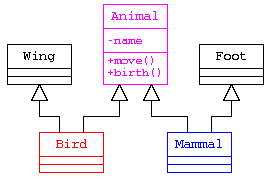派生や集約と多重継承
派生や継承について、一通りの説明が終わったので、データ構造(クラスの構造)の定義の方法にも様々な考え方があり、どのように実装すべきかの問題点を考えるための説明を行う。その中で特殊な継承の問題についても解説する。
動物・鳥類・哺乳類クラス
派生や継承を使うと、親子関係のあるデータ構造をうまく表現できることを、ここまでの授業で示してきた。
しかしながら、以下に述べるような例では、問題が発生する。
// 動物クラス
class Animal {
private:
char name[ 10 ] ;
public:
Animal( const char s[] ) {
strcpy( name , s ) ;
}
const char* get_name() const { return name ; }
virtual void move() = 0 ;
virtual void birth() = 0 ;
} ;
// 鳥類クラス
class Bird : public Animal {
public:
Bird( const char s[] ) : Animal( s ) {}
virtual void move() {
printf( "%s fry.\n" , get_name() ) ;
}
virtual void birth() {
printf( "%s lay egg.\n" , get_name() ) ;
}
} ;
// 哺乳類クラス
class Mammal : public Animal {
public:
Mammal( const char s[] ) : Animal( s ) {}
virtual void move() {
printf( "%s walk.\n" , get_name() ) ;
}
virtual void birth() {
printf( "%s lay baby.\n" , get_name() ) ;
}
} ;
int main() {
Bird chiken( "piyo" ) ;
chiken.move() ;
chiken.birth() ;
Mammal cat( "tama" ) ;
cat.move() ;
cat.birth() ;
return 0 ;
}
ここで、カモノハシを作るのであれば、どうすれば良いだろうか?
鳥類・哺乳類とは別にカモノハシを作る(いちばん無難な方法)
class SeaBream : public Animal {
public:
Mammal( const char s[] ) : Animal( s ) {}
virtual void move() {
printf( "%s walk.\n" , get_name() ) ;
}
virtual void birth() {
printf( "%s lay egg.\n" , get_name() ) ;
}
} ;
この例では、簡単な処理だが、move() の中身が複雑であれば、改めて move() を宣言するのではなく、継承するだけの書き方ができないだろうか?
多重継承を使う方法(ダイヤモンド型継承が発生する)
C++ には、複数のクラスから、派生する多重継承という機能がある。であれば、鳥類と哺乳類から進化したのだから、以下のように書きたい。
// 多重継承 鳥(Bird)と哺乳類(Mammal) から SeaBeam を作る
class SeaBream : public Bird , public Mammal {
//
} ;
しかし、カモノハシに move() を呼び出すと、鳥類の move() と哺乳類の move() のどちらを動かすか曖昧になる。
また「派生」は、基底クラスと派生クラスの両方のデータを持つデータ構造を作る。このため、単純に多重継承を行うと、カモノハシのクラスでは、派生クラスは親クラスのデータ領域と、派生クラスのデータ領域を持つため、鳥類の name[] と、哺乳類の name[] を二つ持つことになる。多重継承による”ダイヤモンド型継承”の問題
足と羽のクラスを作る場合(本来は多重継承で実装すべきではない)
以下に、足と羽のクラスを作ったうえで、多重継承を行うプログラム例を示す。
しかし、この例では、相変わらずカモノハシのクラスを多重継承で実装すると、ダイヤモンド型継承の問題が残る。
class Animal {
private:
char name[ 10 ] ;
public:
Animal( const char s[] ) {
strcpy( name , s ) ;
}
const char* get_name() const { return name ; }
virtual void move() = 0 ;
} ;
// 羽
class Wing {
public:
const char* move_method() { return "fly" ; }
} ;
//
class Leg {
public:
const char* move_method() { return "walk" ; }
} ;
class Bird : public Animal , public Wind {
public:
Bird( const char s[] ) : Animal( s ) {}
virtual void move() {
printf( "%s %s.\n" , get_name() , move_method() ) ;
}
} ;
class Mammal : public Animal , public Leg {
public:
Mammal( const char s[] ) : Animal( s ) {}
virtual void move() {
printf( "%s %s.\n" , get_name() , move_method() ) ;
}
} ;
継承を使うべきか、部品として持つべきか
ただし、ここで述べた方式は、UML による設計の際に改めて説明を行うが、is-a , has-a の関係でいうなら、
- Bird is a Animal. – 鳥は動物である。
- “Bird has a Animal” はおかしい。
- 鳥は、動物から派生させるのが正しい。
- Bird has a Wing. – 鳥は羽をもつ。
- “Bird is a Wing” はおかしい。
- 鳥は、羽を部品として持つべき。
であることから、Wing は 継承で実装するのではなく、集約もしくはコンポジションのような部品として実装すべきである。
このカモノハシ問題をどうしても多重継承で実装したいのなら、C++では、以下のような方法で、ダイヤモンド型の継承問題を解決できる。
class Animal {
private:
char name[ 10 ] ;
public:
Animal( const char s[] ) {
strcpy( name , s ) ;
}
const char* get_name() const { return name ; }
virtual void move() = 0 ;
virtual void birth() = 0 ;
} ;
// 鳥類クラス
class Bird : public virtual Animal {
public:
Bird( const char s[] ) : Animal( s ) {}
virtual void move() {
printf( "%s fry.\n" , get_name() ) ;
}
virtual void birth() {
printf( "%s lay egg.\n" , get_name() ) ;
}
} ;
// 哺乳類クラス
class Mammal : public virtual Animal {
public:
Mammal( const char s[] ) : Animal( s ) {}
virtual void move() {
printf( "%s walk.\n" , get_name() ) ;
}
virtual void birth() {
printf( "%s lay baby.\n" , get_name() ) ;
}
} ;
class SeaBream : public virtual Bird , virtual Mammal {
public:
SeaBream( const char s[] ) : Animal( s ) {}
void move() {
Mammal::move() ;
}
void birth() {
Bird::birth() ;
}
} ;
ただし、多重継承は親クラスの情報と、メソッドを継承する。この場合、通常だと name[] を二つ持つことになるので、問題が発生する。そこで、親クラスの継承に virtual を指定することで、ダイヤモンド型継承の 2つの属性をうまく処理してくれるようになる。
しかし、多重継承は処理の曖昧さや効率の悪さもあることから、採用されていないオブジェクト指向言語も多い。特に Java は、多重継承を使えない。その代わりに interface という機能が使えるようになっている。
多重継承を使える CLOS や Python では、適用するメソッドやインスタンス変数の曖昧さについては親クラスへの優先度を明確にできる機能がある。曖昧さの問題を避けるのであればクラス限定子”::”を使うべきである。

